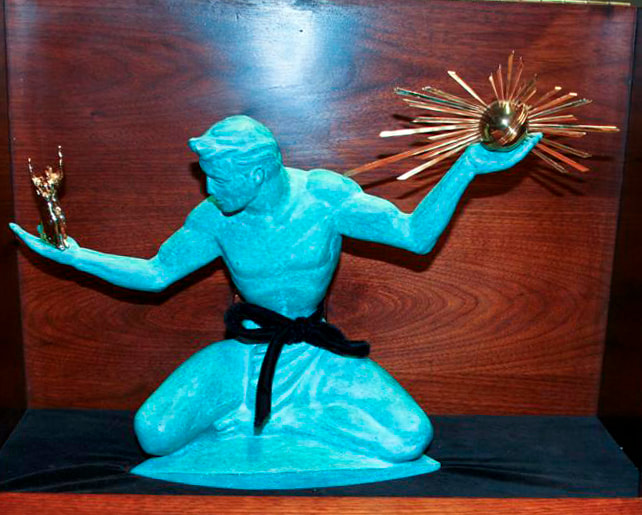MARSHALL FREDERICKS ONLINE EXHIBITIONS
|
When Marshall Fredericks's iconic sculpture The Spirit of Detroit was unveiled on September 23, 1958 demand for memorabilia related to the sculpture commenced. Companies, individuals, and even politicians all wanted to own a small trinket to show their love and admiration for The Spirit of Detroit, and perhaps some even sought to make a profit off of the sculpture's image. Today it's rare to see anything released without careful marketing planning for the product. Memorabilia is often manufactured and sold well ahead of the products release. This was not the case with The Spirit of Detroit. When The Spirit of Detroit arrived by ship from Norway in 1958, four miniature replicas were also aboard. These were cast for Detroit V.I.P's and not offered for sale. Hundreds attended the sculpture's dedication on September 23, 1958, but there were no trinkets, replicas, or souvenirs available to the crowd. Shortly after The Spirit of Detroit was installed letters began to arrive asking Marshall Fredericks how to get products related to The Spirit of Detroit into their hands and onto their shelves, and who would manufacture them. In the letter below, dated October 15, 1959, to Marshall Fredericks from Charles Oakman, General Manager of the Detroit-Wayne Joint Building Authority, the cost of creating inexpensive replicas is discussed. Also in the letter The J.L. Hudson Company expresses their desire to have the replicas on their shelves in time for the Christmas season even though the process for creating the small sculptures would take 6-8 weeks. An October 2, 1959 letter to The J.L. Hudson Company states that a manufacturer in Italy could make small replicas of The Spirit of Detroit for only $10.00 each, and yet another manufacturer could produce key chains for $1.00 each. Hudson's was working against the clock to bring the sculpture's likeness to their stores for the Christmas season, but they were eager to do so. However, in another letter from October 13, 1959, the Hudson's Men's Department buyer seems concerned that the sales demand for replicas might not be that high. The stores would not receive any objects for their holiday shoppers to purchase that year. After the Christmas season ended demand was still high for a replica. A letter dated December 30, 1959 to Marshall Fredericks mentions a request from the Women's Advertising Club. They wanted a Spirit of Detroit replica for their upcoming January meeting. It wouldn't be until several years later before the likeness of the sculpture was actually crafted into an object of memorabilia. Finally, 7 years after the sculpture was installed the Mayor of Detroit, Jerome P. Cavanagh, acquired small medallions from Fredericks with The Spirit of Detroit's likeness to present to distinguished visitors to the city. These medallions were the first souvenirs created with a representation of the popular sculpture. The medallion is mentioned in an April 26, 1965 letter. The letter also states that the demand for miniature sculptures is still on the minds of the citizens of Detroit. Finally a letter of desperation dated May 13, 1965 is written to Fredericks. Seven years have passed since the sculpture was installed, and there is still demand for replicas, but nothing has been created for the public to buy. The letter says the city is "lacking in civic pride" for not making replicas available. The people think enough time has passed, and perhaps it's time to get the Japanese involved to manufacture them cheaply and in bulk. Eventually small replicas created from Fredericks's original molds would be crafted by top bronze casting foundries. Although these were not cheap, they were regraded by Fredericks to be of the finest quality available. They were presented to Presidents and leaders such as President Richard Nixon, President Lyndon Johnson, President Dwight Eisenhower, Mayor Nishiyama of Toyota City, Japan and King Carl XVI Gustaf of Sweden. Once in a great while one of these small Spirit of Detroit replicas comes up at auction. The last one that sold at auction was in 2017. The final hammer price was $34,000. Today it's hard not to see The Spirit of Detroit's iconic image in the city of Detroit. Its likeness has been interpreted, marketed and used in just about any and every way imaginable. Detroiters from the 1950s and 60s would be astounded to see the array of products produced with the sculpture's likeness. T-shirts, magnates, greeting cards, beer cans, pop bottles, stickers, jewelry, tattoos, snow-globes, art, and hundreds of other trinkets and objects of memorabilia are available today. Follow the Instagram hashtag #spiritofdetroit to see the many creative ways The Spirit of Detroit has become the symbol for The Motor City. By: Geoffe Haney ~ Collections Manager
0 Comments
|





